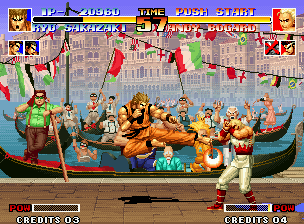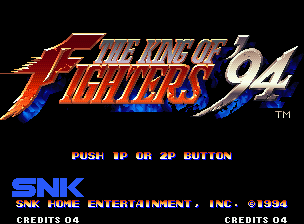Retro Replay Review
Gameplay
The King of Fighters ’94 introduces a refreshing team-based fighting system that was revolutionary at its release. Rather than controlling just a single combatant, players assemble a trio of fighters drawn from SNK’s iconic franchises. You’ll select from characters like Ryo Sakazaki, Terry Bogard, Athena Asamiya, and newcomers such as Kyo Kusanagi or Heavy D. This three-on-three format adds a strategic layer: deciding when to tag in fresh fighters and when to weather your opponent’s offense.
Each match rewards both offensive flair and tactical restraint. While you can unleash standard combos and chain attacks, a key feature is the “Desperation Move” gauge. By holding down your special button, you charge this meter and, once full, perform screen-clearing super moves that can swiftly turn the tide. These DMs operate similarly to Super Combos in later Street Fighter titles, providing a satisfying payoff for well-timed meter management.
Beyond mode selection, the core Arcade challenge pits you against eight rival teams before reaching the final boss, Rugal Bernstein. His brutal strength ensures that every preliminary bout tests your mastery of team composition and move execution. Additionally, the Versus mode offers countless hours of head-to-head play, making this title a staple for local multiplayer sessions. Even decades later, the intuitive controls and looped learning curve keep matches tense and rewarding.
Graphics
Leveraging SNK’s Neo Geo hardware, The King of Fighters ’94 delivers some of the era’s most vibrant sprites and backgrounds. Every character is drawn with meticulous pixel art, conveying personality through fluid animations and signature moves. Whether Terry Bogard’s power wave or Mai Shiranui’s fan toss, the action remains clear and impactful, even in the heat of battle.
Stage designs span a variety of locales—from neon-lit city streets to open‐air arenas—each layered with parallax effects that evoke depth. While the color palette is relatively bold, the careful shading and attention to background detail prevent any visual clutter. This clarity not only helps players read their opponents but also enhances the nostalgic charm that fans continue to celebrate.
Despite its early-’90s release, character portraits and victory animations feel remarkably polished. Each fighter boasts unique win poses and victory quotes, all rendered in crisp pixel art. The result is a visually coherent roster where every combatant stands out, and fights retain a cinematic flair. If you appreciate classic 2D aesthetics, KOF ’94 remains an artful display of sprite-based craftsmanship.
Story
Storytelling in The King of Fighters ’94 is lean but effective. The overarching narrative centers on Rugal Bernstein’s invitation to the greatest fighters from SNK’s franchises. This crossover premise unites casts from Art of Fighting, Fatal Fury, Psycho Soldier, and Ikari Warriors, laying a simple foundation for the tournament’s global stakes.
While detailed character arcs are sparse, the shared tournament setting offers enough context to root for your favorite trio. Newer fighters like Kyo Kusanagi and Benimaru Nikaido receive subtle hints at their mystic lineage and personal motivations, setting the stage for deeper plot development in sequels. For many players, the allure comes from discovering these backstories through successive installments.
Encounters with the enigmatic Rugal serve as the final narrative crescendo. His imposing presence and boss patterns convey an unmistakable “endgame” aura. Although text-based cutscenes are minimal, the mixture of dramatic portraits and in-game commentary delivers a compelling, if concise, arc. In sum, the story functions less as a deep dive and more as a springboard for future series lore.
Overall Experience
The King of Fighters ’94 stands as a landmark in fighting‐game history, courtesy of its innovative team battles and roster diversity. It strikes a balance between accessibility for newcomers and strategic depth for seasoned veterans. Picking your three fighters becomes a meta-game in itself, launching rivalries and favorite pairings that endure in competitive circles.
Locally, the title thrives as a two-player challenge, with tight input responsiveness making each match feel fair and exhilarating. The single-player Arcade mode offers enough difficulty spikes—especially against Rugal—to keep solo players invested. Load times and menus remain snappy, preserving the classic arcade-style flow from cabinet to home console.
For collectors and fighting-game enthusiasts, KOF ’94 is more than a retro relic; it’s a blueprint for team-based combat that influenced countless successors. While modern fighters may boast 3D models and complex story modes, few replicate the simplicity and menu-less precision of this Neo Geo gem. If you’re seeking a piece of fighting-game evolution wrapped in timeless pixel art, The King of Fighters ’94 remains an essential experience.
 Retro Replay Retro Replay gaming reviews, news, emulation, geek stuff and more!
Retro Replay Retro Replay gaming reviews, news, emulation, geek stuff and more!









Reviews
There are no reviews yet.